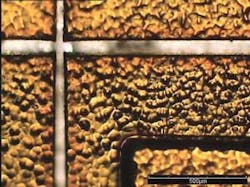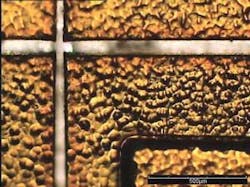Laser improves LED efficiency
Arnaud Brulé and Bernold Richerzhagen
Water jet-guided lasers address challenges surrounding the creation of metal heat sinks for HB-LEDs
Current lighting technology has well-known limitations. Incandescent bulbs are highly inefficient—the bulb expends as much as 90 percent of the energy it conducts on the heat it gives off through the filament. Compact fluorescent lighting (CFL), while touted as a better choice because the bulbs have a longer life and are more efficient, is not viewed as a viable long-term solution due to its mercury content, which poses problems in terms of clean-up and disposal.
The general consensus is that high-brightness light-emitting diodes (HB-LEDs) are the future of the lighting industry. Their key benefits include: high energy efficiency/low electrical consumption; very long operating life (up to 100,000 hours); the ability to direct light for increased system efficiency; robustness and resistance to vibration; a cool, safe-to-the-touch output beam; vivid, fully saturated colors; and instant-on operation.
According to market-research firm Strategies Unlimited, the overall market for HB-LEDs has grown nearly 50 percent per year since 1995, and for HB-LEDs used in lighting applications the market has grown 60 percent per year over the last three years. In 2008 alone, a 12% increase is anticipated, with the total market for packaged HB-LEDs projected to reach $11.4 billion by 2012. The potential applications for this rapidly growing area of lighting technology are practically limitless, reaching beyond conventional home and industrial applications to areas such as medical devices, automotive and architectural lighting, backlighting for displays, and a host of new consumer products.
With that said, HB-LEDs pose some challenges in terms of their manufacture. They’re grown by using sophisticated epitaxial growth techniques such as metal-organic chemical vapor deposition (MOCVD)—a complex process that relies on chemical reaction for crystal growth rather than physical deposition. Because of the high amount of power pumped through the diode, HB-LEDs require a heat sink, which cools the device and efficiently reflects heat away to help optimize its functionality. Effective heat sinking is a key factor in ensuring stable LED performance over a long lifetime. Heat sinks are made of a high-conductivity metal—typically, copper (Cu), molybdenum (Mo), and their alloys, such as copper tungsten (CuW)—to help preserve the device’s lifetime and maintain maximum luminosity output.
However, cutting these metals cost effectively has been a problem, as conventional cutting techniques can create damage and contamination that hamper not only the manufacturing process but also the LED’s performance and efficiency.
Cutting approaches
With mechanical cutting (saw blades), the metals used in heat sinks wear down the grains of diamond saw blades much more rapidly than conventional wafer packages. This is because the diamond particles are coated with a resin that attracts particles from the soft metals, which fill the gaps in the blade and dull them, necessitating frequent, costly blade changes. Moreover, diamond saws create a serious problem with contamination, as the particles that don’t stick to the saw fly back onto the surface. This significantly reduces the luminosity and therefore the efficiency of the HB-LED device. Although saw blades can run very fast, these problems cause them to break down quickly, and optimizing them for cutting quality causes them to run unacceptably slowly. The cost of ownership impact makes diamond saws a highly costly choice for this application.
Infrared (IR) or green “dry” lasers generate a great deal of heat and, consequently, heat damage to the soft metals used for the HB-LED heat sinks. These materials do not disperse easily after being transformed into a plasma state and remain within the kerf, either as burrs or recast spanning the kerf width, thus impeding die separation. Increasing the blow jet does not increase plasma removal efficiency but instead tends to distribute recast from the kerf onto the active areas of the HB-LED arrays, lowering yields. Again, this also harms the functionality and efficiency of the devices and raises the device maker’s operating cost for the laser.
Ultraviolet lasers (UV) operate more efficiently than IR and green lasers, as they generate less heat during their operation. However, they run at speeds that are far too slow for the thicknesses involved, which range from 100–500µm. Even at lower power, they still generate some heat damage and contamination. The bottom line is that, due to the size of the heat-affected zone (HAZ) (up to 60µm), the edge quality of HB-LED metals cut with conventional lasers has been shown to be sub-standard for meeting the market requirements
A third technique is the use of a water jet-guided laser (patented and marketed by Synova as the Laser MicroJet). Developed for medical applications and currently used for precision micromachining of semiconductors and electronics, the technology uses an ultra-thin, low-pressure water jet to guide a laser beam to the work surface. The capabilities and performance of this process are different from those of conventional dry lasers. First, because the water jet is cylindrical and the laser beam parallel, the kerf walls are parallel. The working distance—corresponding to the stable length of the jet—can be several centimeters long, depending on the jet diameter, so focus control is not necessary. The laser remains focused in the water jet.
Second, heat damage is nonexistent, as the water jet cools the edges between the laser pulses. The temperature of the cut edge rapidly decreases to the water temperature, and any heat generated by the laser is not conducted further into the material. This effectively eliminates the damage associated with heating—e.g., micro-cracks, oxidation, structural changes, or low die fracture strength—while enabling up to a ten-fold reduction in size of the HAZ.
Third, the water jet greatly reduces contamination. Its pressure ranges from 50–500 bars, enabling it to develop a high kinetic energy fully dedicated to the removal of the molten material. At the same time, because the water jet is very thin (diameter ranging from 20–100µm), the mechanical force applied on the wafer is negligible (less than 0.1N), so the process generates no chipping or micro-cracks.
Fourth, using the water jet enables ease and speed of cutting molten metal with a large kinetic impact—metals up to 600µm thick can be cut in just 1–3 seconds using the water jet, with smooth, well-defined, and consistently high-quality edges (see Figure 1). The water jet can cut HB-LEDs in any shape—square, round, hexagonal, etc. (see Figure 2). This enables better, more economical use of material with less waste. Depending on the end application, a unique shape for the LED may be required, and the water jet is far better suited to the task. Furthermore, contamination is eliminated by the jet’s ability to quickly cool and wash away particles before they have a chance to redeposit on the wafer surface. The table illustrates the breadth of the water jet laser’s capabilities in cutting copper-embedded HB-LEDs of various sizes and thicknesses.
Meeting new requirements
There are several approaches to HB-LED fabrication/packaging currently in use. One is to build active devices on top of metal wafers, and then dice the wafers into individual chips. Dicing these materials efficiently is difficult, as they are too heavy for IR or green lasers, both of which utilize a gas jet to blow out molten material, but the kinetic energy of the air jet isn’t powerful enough for this application. Also, the high heat generated by the laser can cause the edges of the material to burn during the cutting process, creating irreparable damage.
Another approach is to build the LED device on a sapphire or silicon carbide (SiC) wafer and then cut the LEDs with a saw blade. As the cooling process is not efficient, the manufacturer lays out the HB-LEDs in an array, overmolds them with copper, and then performs a polishing step, yielding a pure copper wafer with active HB-LEDs embedded inside, with only the emission surface exposed out of the copper. The water-guided laser is ideal for singulating these encapsulated chips, as their unique packaging and high amount of heat sink makes them greatly susceptible to damage from other approaches.
National programs to promote and develop LEDs for lighting are under development in the US, as well as throughout Asia, in regions where the technology holds the greatest promise for growth, including Japan, Taiwan, Korea, and China. With lighting accounting for ~20 percent of total electricity consumption, these programs are focused on pursuing large-scale energy savings, helping consumers reduce their energy costs, and helping the environment through lower greenhouse gas emissions. However, the greatest driving force in the illumination market for HB-LEDs is their use in new applications where traditional lighting has significant disadvantages, or reliability and other LED-specific factors are of particular note. And with HB-LEDs on the verge of a growth spurt, the Laser MicroJet water-guided laser is similarly poised to undergo strong growth.
Arnold Brule is marketing manager and Bernold Richerzhagen ([email protected]) is CEO and president of Synova S.A, (www.synova.ch), Ecublens, Switzerland.


